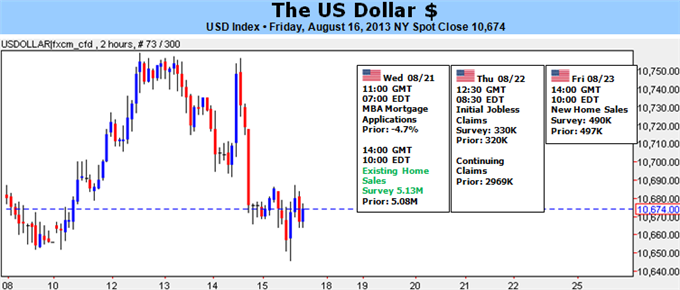
Why the Dollar Will Surge if the Dow’s Slide Accelerates
Fundamental Forecast for US Dollar: Neutral
Economists survey show probability for September Taper hits 65% but reduction only $10 billion
GBPUSD among the majors positioned for a dollar turn?
New to Forex? Watch this introduction video
It’s a relationship that has many FX traders scratching their heads. The Dow Jones Industrial Average has marked a painfully-obvious technical breakdown, and yet the renowned safe haven US dollar is still threatening to collapse into plunge itself. Yet, don’t position for AUDUSD and GBPUSD rallies just yet. If the equities’ stumble turns into wholesale deleveraging, the greenback will soar.
In an ideal world, the standard lines of fundamental analysis would be clear cut and immediately accessible. However, in the financial markets where thousands of variables dictate where millions of traders position their capital; it is unwise to expect an easy navigation. Simple and straight forward trends in the chaos of a multivariate market develop when the vast majority of participants (or at least the capital that they control) are positioning towards the same goal. Few ‘themes’ can align such a behemoth, but risk appetite and the influence of a central bank are certainly two that can top the list.
So, that brings us back to the dollar’s performance this past week. If the Dow and S&P 500 marked inauspicious reversals, why did the reserve currency not surge in response? While the equity tumble is certainly menacing, it has yet to shake the foundations of investor confidence. A basic challenge to cries of a full-scale fear move would be reservations of the market-favorite VIX Volatility Index. While the ‘Fear gauge’ rose to its highest level in six weeks, the 14.4 percent reading is barely off five-year average lows and a third lower than the post-June FOMC rate decision swing high.
The ultimate consequence of a market-wide risk aversion move is the unilateral transfer of capital away from assets deemed risky and into those that provide liquidity and stability. Such a stampede easily jumps the boundaries of asset classes. However, it is not easy to escalate concern to that level. Over the past weeks and months (even years), there has been a steady buildup of fundamental motive to see record high capital markets and carry trade turn. Leverage use hit record highs, participation has troughed to 15-year lows, real rates of return slumped and a dependency was developed around central bank support. While each of these issues is troubling, they don’t necessarily sink the market. A catalyst needs to start the ball rolling and align traders’ fears.
Fear of the Fed taking the first step to moderate its support of the markets via is QE3 stimulus line (otherwise known as the ‘Taper’) is one of those scenarios with the gravitas to orchestrate a reversal in capital flows. It is possible that this past week’s Dow slide is in part a result of that fear. Another round of data and Fed speak certainly keep the September time frame for de-escalation in the support program in place. However, why did the dollar not rally in concert if that were the case?
If we look at various benchmarks with a sensitivity to Fed stimulus over the past months (dollar, Treasuries, carry trade and equities), we see that there may have been some permanent adjustment to the likelihood of Taper beginning some months ago. US government bonds (which the Fed directly buys as party of QE3) began their tumble at the beginning of May for example. If we have already been adjusting to a life without moral hazard that can diminish the impact of the eventual September meeting. However, that doesn’t mean the S&P 500 is safe and the dollar is at the end of its run. There is still excessive leverage and risk in the system, and it can be unwound…in a volatile manner. Perhaps the best confirmation for a strong and lasting dollar rally through all of this would be a rally in Treasuries (10-year yield drop). A Taper will reduce Treasury purchases, but need for liquidity will leverage a bid that soundly offsets that unwind. And, that level of concern overriding speculative common sense (not to mention the need to have USD to buy Treasuries) is severe.
As headline-worthy as last week’s equity spill is, we may still need a spark to reach terminal velocity. Looking at the docket for the week ahead, there aren’t many definitive catalysts that promise to prevail where other event risk (CPI, NFPs, clear Fed speak, etc) has fallen short. The most decisive event is Wednesday’s FOMC minutes. If there was a growing call for the Taper at the previous meeting, it will reinforce the September time frame. Another worthy event is the Jackson Hole Economic Symposium that runs from Thursday to Saturday. In past years, serious US monetary policy moves have been introduced at this event. That said, Chairman Bernanke’s absence seems to stall speculation in its tracks. In the end, it may just be a cascade in positioning that puts these markets on pace. – JK
Written by: John Kicklighter, Chief Strategist
Sign up for John’s email distribution list, here.
DailyFX provides forex news and technical analysis on the trends that influence the global currency markets.Learn forex trading with a free practice account and trading charts from FXCM.
Source: Daily fx

